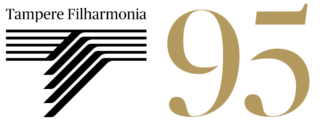Afternoon of Fauns: Bold as Brass! – amid intense emotions
Programme
Sergei Rahmaninov: Sonata for cello and piano
I Lento – moderato II Allegro scherzando III Andante IV Allegro mosso
Sirja Nironen, cello and Tuomas Turriago, piano
intermission
George Gershwin (arr. Zhihan Xu): Rhapsody in Blue
Astor Piazzolla (arr. Zhihan Xu): Fuga y Misterio, Oblivion
Programme
Sergei Rahmaninov: Sonata for cello and piano
I Lento – moderato II Allegro scherzando III Andante IV Allegro mosso
Sirja Nironen, cello and Tuomas Turriago, piano
intermission
George Gershwin (arr. Zhihan Xu): Rhapsody in Blue
Astor Piazzolla (arr. Zhihan Xu): Fuga y Misterio, Oblivion, Libertango
Xiang Guo, trumpet, Maria Garcia, violin, Tatevik Ayazyan, violin, Anni Tiainen-Hammo, viola, Reinis Birznieks, cello and Juha Kleemola, double bass
In 1897 Sergei Rachmaninov (1874-1947) became depressed. His intended breakthrough symphony was a total flop, and he spent the next few years drinking instead of composing. It was only through hypnotherapy that he managed to get back to his drawing board. His first compositions were the Second Piano Concerto (1901) - his real breakthrough - and the Sonata for Cello and Piano, premiered three weeks later.
Sergei Rachmaninov’s four-movement Sonata for cello and piano has the strong echo of Russian harmonies and wistful passion typical of his concertos. The work should not be called a sonata for cello, for as the foremost pianist of his time, Rachmaninov certainly did not leave the piano as accompanist, but made the instruments equal partners. Admittedly, most of the themes are first introduced by the piano until the cello takes them over.
It was January 3, 1924, when George Gershwin (1898-1937) was struck by a newspaper ad: "George Gershwin is preparing a jazz concerto for Abraham Lincoln's birthday concert on February 12..." The information was confusing, as no one had warned him that he would have to prepare the work for a world premiere in about a month. On a train journey Gershwin came up with the theme of the work, the rumble of the railroad and the American vigour; a rhapsody of themes, encapsulating the diversity of the country as if told through a kaleidoscope. But time was running out: only a sketch, suitable for improvisation, was completed and arranged for orchestra and piano by Ferde Grofé. Despite its awkward premiere, Rhapsody eventually became Gershwin's greatest hit and a resounding symbol of the New York lifestyle.
As a teenager, the Argentinean Astor Piazzolla (1921-1992) was already composing new tangos for the clubs of his hometown Mar del Plata to dance to. Deep down, he wanted to be a 'serious composer'. In 1954, after taking a series of composition lessons from Nadia Boulanger in Paris, Piazzolla returned home, and then developed the Tango Nuevo - a new tango, a style of music that would not be danced but listened to. Initially considered almost sacrilegious, Piazzolla's works have become the musical heartbeat of contemporary Argentina.
Buy tickets online, click "Additional Information" link! Adults 17 € / pensioners 10 € / students, unemployed, conscripts and children under 17 yrs 7 €
Sergei Rahmaninov: Sonata for cello and piano
I Lento – moderato II Allegro scherzando III Andante IV Allegro mosso
Sirja Nironen, cello and Tuomas Turriago, piano
intermission
George Gershwin (arr. Zhihan Xu): Rhapsody in Blue
Astor Piazzolla (arr. Zhihan Xu): Fuga y Misterio, Oblivion, Libertango
Xiang Guo, trumpet, Maria Garcia, violin, Tatevik Ayazyan, violin, Anni Tiainen-Hammo, viola, Reinis Birznieks, cello and Juha Kleemola, double bass
In 1897 Sergei Rachmaninov (1874-1947) became depressed. His intended breakthrough symphony was a total flop, and he spent the next few years drinking instead of composing. It was only through hypnotherapy that he managed to get back to his drawing board. His first compositions were the Second Piano Concerto (1901) - his real breakthrough - and the Sonata for Cello and Piano, premiered three weeks later.
Sergei Rachmaninov’s four-movement Sonata for cello and piano has the strong echo of Russian harmonies and wistful passion typical of his concertos. The work should not be called a sonata for cello, for as the foremost pianist of his time, Rachmaninov certainly did not leave the piano as accompanist, but made the instruments equal partners. Admittedly, most of the themes are first introduced by the piano until the cello takes them over.
It was January 3, 1924, when George Gershwin (1898-1937) was struck by a newspaper ad: "George Gershwin is preparing a jazz concerto for Abraham Lincoln's birthday concert on February 12..." The information was confusing, as no one had warned him that he would have to prepare the work for a world premiere in about a month. On a train journey Gershwin came up with the theme of the work, the rumble of the railroad and the American vigour; a rhapsody of themes, encapsulating the diversity of the country as if told through a kaleidoscope. But time was running out: only a sketch, suitable for improvisation, was completed and arranged for orchestra and piano by Ferde Grofé. Despite its awkward premiere, Rhapsody eventually became Gershwin's greatest hit and a resounding symbol of the New York lifestyle.
As a teenager, the Argentinean Astor Piazzolla (1921-1992) was already composing new tangos for the clubs of his hometown Mar del Plata to dance to. Deep down, he wanted to be a 'serious composer'. In 1954, after taking a series of composition lessons from Nadia Boulanger in Paris, Piazzolla returned home, and then developed the Tango Nuevo - a new tango, a style of music that would not be danced but listened to. Initially considered almost sacrilegious, Piazzolla's works have become the musical heartbeat of contemporary Argentina.
Buy tickets online, click "Additional Information" link! Adults 17 € / pensioners 10 € / students, unemployed, conscripts and children under 17 yrs 7 €
Dates
10.12.2023
Time
15.00 - 16.45
Location
33100
